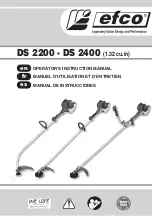
CRANKCASE
14
36
Leakage test
A leaking crankcase results in reduced crankcase compression. A typical sign is
that the machine is difficult to start.
Tools
Tools 502 71 39-01 and 506 34 45-01 are required during the leakage test to
seal the exhaust port and inlet port. Replace the decompression valve with
sealing plug 503 55 22-01.
Pressure tester 531 03 06-23, or the like, is needed for the test.
Important
Turn the crankshaft so that the inlet port is fully open, i.e. that the piston is
at its upper turning point.
Clutch lubrication channel
1. Seal the clutch lubrication channel with tape
Sealing plug
2. Fit the sealing plug 503 55 22-01 in the cylinder
space for the decompression valve.
Inlet port
3. Remove the carburettor and inlet pipe.
4. Fit the sealing washer 502 71 38-01.
Exhaust port
5. Remove the cutting deck and muffler as shown
on Pages 6 and 8 respectively.
6. Fit the sealing washer 502 71 39-01 with the
screws belonging to the muffler.
Test the tightness
Connect the pressure tester to the nipple on the inlet seal.
Pump up a pressure to 80 kPa. After 30 seconds, the pressure must not have
fallen below 60 kPa.
If the test shows leaks
Check at the location of the leak by brushing on soapy water, or using a leak
spray. Before anything else, check the sealing rings at the crankshaft. Secondly,
check the tightness of the seals (crankcase halves, cylinder foot). The third
possibility is crack formation in the crankcase.
531 03 06-23
4
1
3
6
5
2
502 71 38-01
502 71 39-01
503 55 22-01
















































